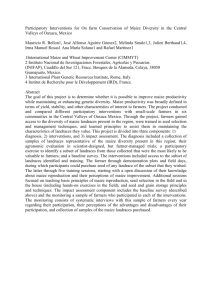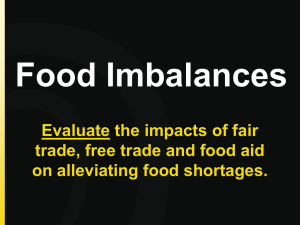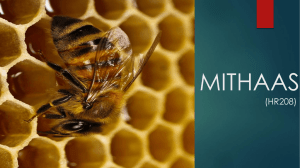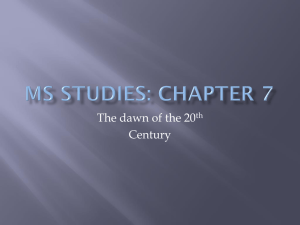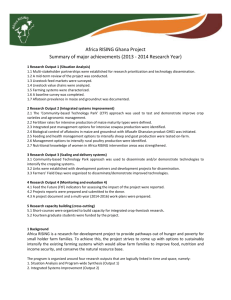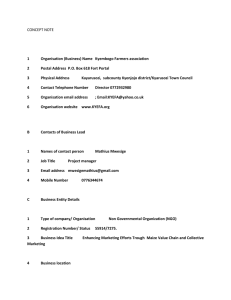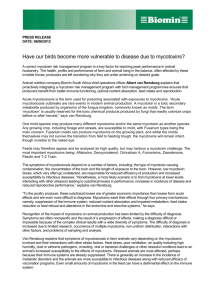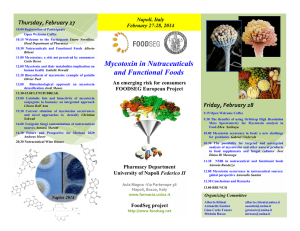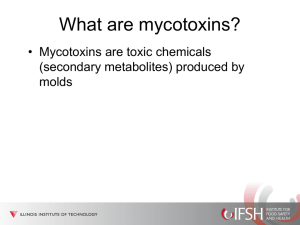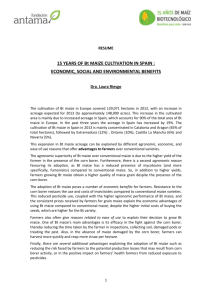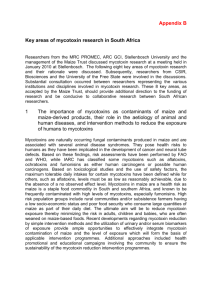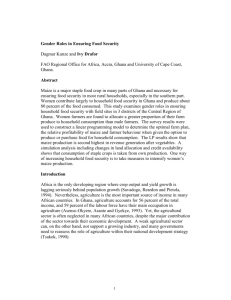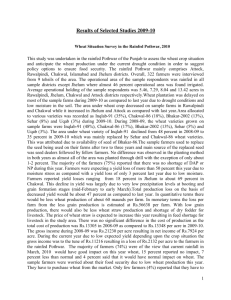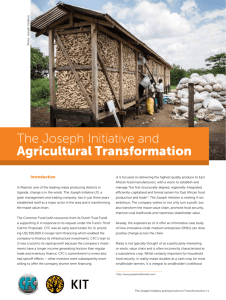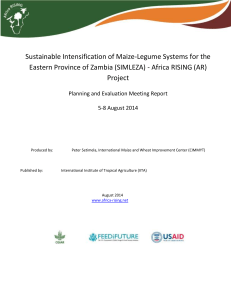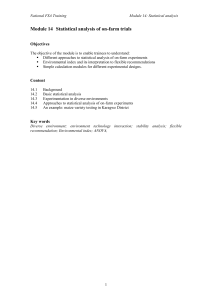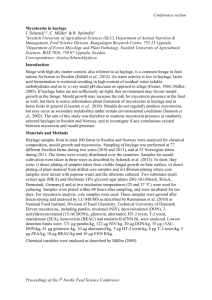Innovative Approaches to Dealing with the Incentive Problem
advertisement
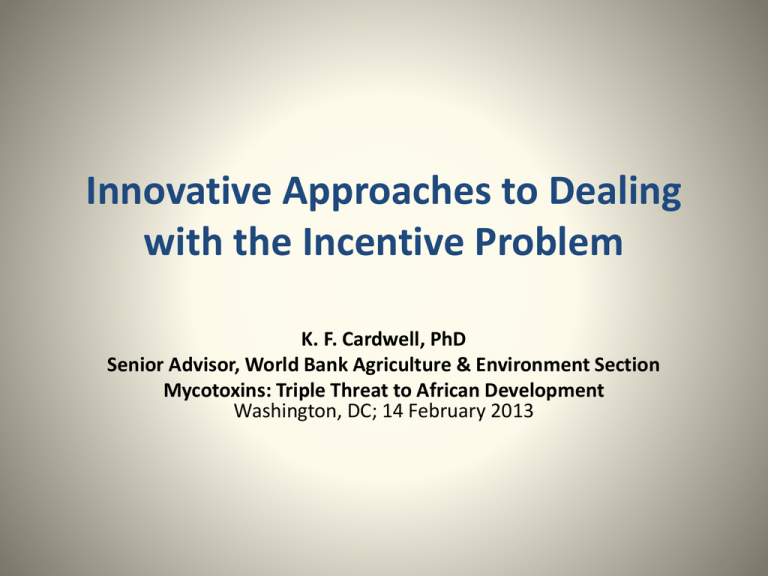
Innovative Approaches to Dealing with the Incentive Problem K. F. Cardwell, PhD Senior Advisor, World Bank Agriculture & Environment Section Mycotoxins: Triple Threat to African Development Washington, DC; 14 February 2013 How Social Marketers See Incentives – Just Do What? • Think in terms of customers, not converts. For our customers, a shared worldview is not a prerequisite to action. • People don’t need to know everything; they want to know what is relevant to them. • Either we can try (in vain) to get them to see the same way we do, or we can work from their perspective. Robin Hood Marketing, Andresen, 2006 Re Mycotoxins, What do we want from them vs What is their perspective? • Governments; • Farmers; • Animal feeds consumers/food and beverage processers; • Urban Marketers; • Urban and Rural Consumers; • International Traders. How Governments See the What • What Government Ministries want – Positive public perception: to be seen to be effective and in control of situation: agricultural competitiveness; public health; food security and safety. • For Mycotoxins the What is for Governments to – Internally regulate food safety (monitoring and control); – Balance public health, food safety and food security; – Oversee markets and trade; and – Enact policies that promote REE on mycotoxins. What Farmers Want – Maximized farm income; – Minimized income variation; – Minimized variable costs; – Minimized variable cost variation; – Minimized additional labor; – Maintained previous activity level (representing aversion to change); AND – Household health and well-being (esp children). From Behaviour and motivations of farmers in responding to policy changes . Reading Univ, UK How Farmers See the What • What Mycotoxin Management Calls for: – Change of management practices; – Additional labor; – Additional cost; – Income/yield neutral activities (in absence of incentive); – Potential income variability and/or liability; • How does this balance with the desire for a healthy household? Remember How Social Marketers See Incentives • Think in terms of customers, not converts. For our customers, a shared worldview is not a prerequisite to action. – Do Farmers need to care about Public Health? – Will Farmers find food safety for their families a great enough incentive to change their production systems? – How do we see Farmers as customers? • People don’t need to know everything; they want to know what is relevant to themselves. Robin Hood Marketing, Andresen, 2006 What is the strategy for farmers? • Couple mycotoxin management with increased income potential; • Couple mycotoxin management with improved productivity; versus • Regulate and penalize; • Scare the hell out of everybody with negative health campaigns about staple foods to create a demand? What Urban Maize Marketers Want • Ease of purchase at farm gate or from aggregator; • Less labor requirements; • Stable transport and storage; • Profitability (buy low, sell high); • Minimized losses; • Return Customers. How Marketers see the What • What we want of them is to sell maize at a slightly higher price if it has low myco/afla-toxin. • What incentive do they have to do that? – Pull-mechanism incentives – a bonus (short term); – Market force price differential - Informed and savvy consumers – (medium term); – Regulatory – risk of penalty and public opinion (long term); and/or – Concern for their own children’s health. What Maize Consumers Want • Low price; • Good quality; • Convenient location for purchase; • Convenience for preparation; • Consistent taste and Cooking characteristics. What we want from the Customer • For them to purchase mycotoxin-free product for a slightly higher price and seek vendors that sell Aflasafe maize. • Why would they do that? What would social marketers say about how much information the consumer needs? • How much information is too much information? • Choosey Mothers Choose Jiff! Back to What for the Farmers • Want them to manage aflatoxin (other toxins?) with – Cultural techniques of which there are about 15 that need to be used in conjunction; – Biological control – for which there is a cost and some additional labor; • What do we say to them? Do/use this and it will be worth your while! • Meanwhile, for this to happen and be sustainable, all other elements have to align. Players and Motivations We have to get a handle on this can of worms!! Will you pay me more? Dev Country Governments Quality or price? Will I pay you more? So much work! Marketers Consumers Cheep moi? I’ll pay more! Farmers Industrial consumers Food Security AFLASAFE ™ Incentivization Pilot in Nigeria Pull Mechanism Initiative Organizational Chart Donor’s Steering Committee Financial Trustee Nigerian Bank (s)? AG-Results Secretariat (TBD) Oversight Stakeholders Aflasafe Pilot Steering Committee 1. Doreo Partner (Chair) 2. MAN 3. PAN 4. Food Safety Committee 5. Finance 6. Women traders’ rep Ag-Results Evaluator (TBD) Program supervisor Incentive payments Program Management Monitoring and Technical Evaluation Outreach, verification, Aflasafe manufacturing Technical Ops Teams Field Initiative Implementer 4 Babban Gona Implementer 2 Masala and Premier Commercial Aggregators Implementer 3 Kaduna CADP Implementer 1 Women marketer Strategic Plan to Drive Sustainability Leverage Strong Regulatory Enforcement to Sustain Premium Market for Aflasafe maize 1 Supply of Affordable LowAflatoxin Maize CADPs and Pull Mechanism Incentives 2 Enable Market Forces to Drive Sustainability Market Forces 3 Health Awareness: Farmer Focus Public Health Awareness Health Awareness: Industry Focus 4 Enforce Regulatory Policy Policy: Build Regulators Capacity Policy: Develop regulatory framework 1 2 Health Awareness: End Consumer Policy: Phased in regulatory enforcement mechanism 3 Year 4 5 Doreo Partners Thank you for your comments and thoughts. kcardwell@worldbank.org bmasha@gmail.com gdixie@worldbank.org r.bandyopahdyay@iita.cgiar.org



